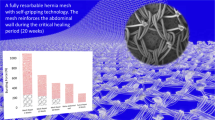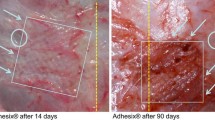Abstract
Purpose
To evaluate the biocompatibility of heavyweight polypropylene (HWPP), lightweight polypropylene (LWPP), and monofilament knit polytetrafluoroethylene (mkPTFE) mesh by comparing biomechanics and histologic response at 1, 3, and 5 months in a porcine model of incisional hernia repair.
Methods
Bilateral full-thickness abdominal wall defects measuring 4 cm in length were created in 27 Yucatan minipigs. Twenty-one days after hernia creation, animals underwent bilateral preperitoneal ventral hernia repair with 8 × 10 cm pieces of mesh. Repairs were randomized to Bard®Mesh (HWPP, Bard/Davol, http://www.davol.com), ULTRAPRO® (LWPP, Ethicon, http://www.ethicon.com), and GORE®INFINIT Mesh (mkPTFE, Gore & Associates, http://www.gore.com). Nine animals were sacrificed at each timepoint (1, 3, and 5 months). At harvest, a 3 × 4 cm sample of mesh and incorporated tissue was taken from the center of the implant site and subjected to uniaxial tensile testing at a rate of 0.42 mm/s. The maximum force (N) and tensile strength (N/cm) were measured with a tensiometer, and stiffness (N/mm) was calculated from the slope of the force-versus-displacement curve. Adjacent sections of tissue were stained with hematoxylin and eosin (H&E) and analyzed for inflammation, fibrosis, and tissue ingrowth. Data are reported as mean ± SEM. Statistical significance (P < 0.05) was determined using a two-way ANOVA and Bonferroni post-test.
Results
No significant difference in maximum force was detected between meshes at any of the time points (P > 0.05 for all comparisons). However, for each mesh type, the maximum strength at 5 months was significantly lower than that at 1 month (P < 0.05). No significant difference in stiffness was detected between the mesh types or between timepoints (P > 0.05 for all comparisons). No significant differences with regard to inflammation, fibrosis, or tissue ingrowth were detected between mesh types at any time point (P > 0.09 for all comparisons). However, over time, inflammation decreased significantly for all mesh types (P < 0.001) and tissue ingrowth reached a slight peak between 1 and 3 months (P = 0.001) but did not significantly change thereafter (P > 0.09).
Conclusions
The maximum tensile strength of mesh in the abdominal wall decreased over time for HWPP, LWPP, and mkPTFE mesh materials alike. This trend may actually reflect inability to adequately grip specimens at later time points rather than any mesh-specific trend. Histologically, inflammation decreased with time (P = 0.000), and tissue ingrowth increased (P = 0.019) for all meshes. No specific trends were observed between the polypropylene meshes and the monofilament knit PTFE, suggesting that this novel construction may be a suitable alternative to existing polypropylene meshes.






Similar content being viewed by others
References
Burger JW, Luijendijk RW, Hop WC, Halm JA, Verdaasdonk EG, Jeekel J (2004) Long-term follow-up of a randomized controlled trial of suture versus mesh repair of incisional hernia. Ann Surg 240:578–583
Luijendijk RW, Hop WC, van den Tol MP, de L, Braaksma MM, IJzermans JN, Boelhouwer RU, de Vries BC, Salu MK, Wereldsma JC, Bruijninckx CM, Jeekel J (2000) A comparison of suture repair with mesh repair for incisional hernia. N Engl J Med 343:392–398
Park AE, Roth JS, Kavic SM (2006) Abdominal wall hernia. Curr Probl Surg 43:326–375
US Health and Human Services PHS (2010) The animal studies committee manual guidelines for the care and use of research animals. http://www.asc.wustl.edu/manual/index.html
Jenkins ED, Melman L, Deeken CR, Greco SC, Frisella M, Matthews BD (2010) Evaluation of fenestrated and non-fenestrated biologic grafts in a porcine model of mature ventral incisional hernia repair. Hernia 14:599–610
ISO 10933-6/ASTM 981-99 (2003) Annual book of ASTM standards. ASTM
Leber GE, Garb JL, Alexander AI, Reed WP (1998) Long-term complications associated with prosthetic repair of incisional hernias. Arch Surg 133:378–382
Usher FC, Ochsner J, Tuttle LJ (1958) Use of marlex mesh in the repair of incisional hernias. Am Surg 24:969–974
Bellon JM, Rodriguez M, Garcia-Honduvilla N, Gomez-Gil V, Pascual G, Bujan J (2009) Comparing the behavior of different polypropylene meshes (heavy and lightweight) in an experimental model of ventral hernia repair. J Biomed Mater Res B Appl Biomater 89B:448–455
Bellon JM, Rodriguez M, Garcia-Honduvilla N, Gomez-Gil V, Pascual G, Bujan J (2008) Postimplant behavior of lightweight polypropylene meshes in an experimental model of abdominal hernia. J Invest Surg 21:280–287
Cobb WS, Kercher KW, Heniford BT (2005) The argument for lightweight polypropylene mesh in hernia repair. Surg Innov 12:63–69
Hollinsky C, Sandberg S, Koch T, Seidler S (2008) Biomechanical properties of lightweight versus heavyweight meshes for laparoscopic inguinal hernia repair and their impact on recurrence rates. Surg Endosc 22:2679–2685
Majercik S, Tsikitis V, Iannitti DA (2006) Strength of tissue attachment to mesh after ventral hernia repair with synthetic composite mesh in a porcine model. Surg Endosc 20:1671–1674
Burger JW, Halm JA, Wijsmuller AR, ten RS, Jeekel J (2006) Evaluation of new prosthetic meshes for ventral hernia repair. Surg Endosc 20:1320–1325
Klinge U, Conze J, Limberg W, Brucker C, Ottinger AP, Schumpelick V (1996) Pathophysiology of the abdominal wall. Chirurg 67:229–233
Junge K, Klinge U, Prescher A, Giboni P, Niewiera M, Schumpelick V (2001) Elasticity of the anterior abdominal wall and impact for reparation of incisional hernias using mesh implants. Hernia 5:113–118
Cobb WS, Burns JM, Peindl RD, Carbonell AM, Matthews BD, Kercher KW, Heniford BT (2006) Textile analysis of heavy weight, mid-weight, and light weight polypropylene mesh in a porcine ventral hernia model. J Surg Res 136:1–7
Klinge U, Klosterhalfen B, Muller M, Schumpelick V (1999) Foreign body reaction to meshes used for the repair of abdominal wall hernias. Eur J Surg 165:665–673
Luijendijk RW, de L, Wauters CC, Hop WC, Duron JJ, Pailler JL, Camprodon BR, Holmdahl L, van Geldorp HJ, Jeekel J (1996) Foreign material in postoperative adhesions. Ann Surg 223:242–248
Duffy DM, di Zerega GS (1996) Adhesion controversies: pelvic pain as a cause of adhesions, crystalloids in preventing them. J Reprod Med 41:19–26
Menzies D (1993) Postoperative adhesions: their treatment and relevance in clinical practice. Ann R Coll Surg Engl 75:147–153
Menzies D, Ellis H (1990) Intestinal obstruction from adhesions—how big is the problem? Ann R Coll Surg Engl 72:60–63
Bageacu S, Blanc P, Breton C, Gonzales M, Porcheron J, Chabert M, Balique JG (2002) Laparoscopic repair of incisional hernia: a retrospective study of 159 patients. Surg Endosc 16:345–348
Heniford BT, Park A, Ramshaw BJ, Voeller G (2003) Laparoscopic repair of ventral hernias: 9 years’ experience with 850 consecutive hernias. Ann Surg 238:391–399
Wassenaar EB, Schoenmaeckers EJ, Raymakers JT, Rakic S (2009) Recurrences after laparoscopic repair of ventral and incisional hernia: lessons learned from 505 repairs. Surg Endosc 23:825–832
Klosterhalfen B, Junge K, Klinge U (2005) The lightweight and large porous mesh concept for hernia repair. Expert Rev Med Devices 2:103–117
Klinge U, Klosterhalfen B, Muller M, Ottinger AP, Schumpelick V (1998) Shrinking of polypropylene mesh in vivo: an experimental study in dogs. Eur J Surg 164:965–969
Scheidbach H, Tamme C, Tannapfel A, Lippert H, Kockerling F (2004) In vivo studies comparing the biocompatibility of various polypropylene meshes and their handling properties during endoscopic total extraperitoneal (TEP) patchplasty: an experimental study in pigs. Surg Endosc 18:211–220
Acknowledgments
This study was supported by a research grant from W.L. Gore & Associates, Inc., (Flagstaff, AZ).
Author information
Authors and Affiliations
Corresponding author
Rights and permissions
About this article
Cite this article
Melman, L., Jenkins, E.D., Hamilton, N.A. et al. Histologic and biomechanical evaluation of a novel macroporous polytetrafluoroethylene knit mesh compared to lightweight and heavyweight polypropylene mesh in a porcine model of ventral incisional hernia repair. Hernia 15, 423–431 (2011). https://doi.org/10.1007/s10029-011-0787-z
Received:
Accepted:
Published:
Issue Date:
DOI: https://doi.org/10.1007/s10029-011-0787-z




